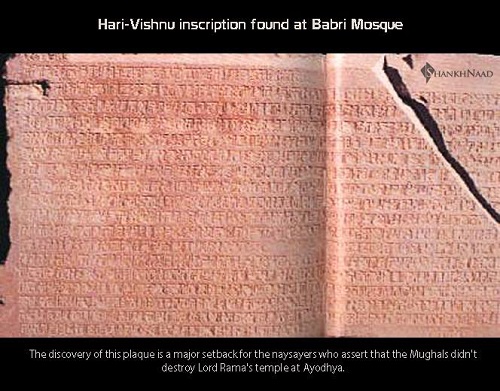There are archeological evidence that two Rama temples stood at the Ayodha site, and history suggests that both were destroyed by Muslims invaders. The first may have existed in the 12th century and been destroyed by Muslim invaders following Muhammad of Ghor’s defeat of Prithviraj Chauhan in the second battle of Tarain, 1192 A.D. This temple appears to have been rebuilt, then destroyed a second time by Babur in the 16th century.
The ruins unearthed numerous relics that appear to prove definitively that the Ram temple did exist in ruins under the mosque. The discovery of a stone plaque with an inscription documenting a 12th century Hari-Visnu temple at the site.
The inscription is composed in high-flown Sanskrit verse, except for a very small portion in prose, and is engraved in chaste and classical Nagari script of the eleventh-twelfth century AD. It has yet to be fully deciphered, but the portions which have been fully deciphered and read are of great historical significance and value … [It has since been fully deciphered.] It was evidently put up on the wall of the temple, the construction of which is recorded in the text inscribed on it.
Line 15 of this inscription, for example, clearly tells us that a beautiful temple of Vishnu-Hari, built with heaps of stones … , and beautified with a golden spire … unparalleled by any other temple built by earlier kings … This wonderful temple … was built in the temple-city of Ayodhya situated in Saketamandala. …
Line 19 describes god Vishnu as destroying king Bali … and the ten headed personage (Dashanana, i.e., Ravana)

